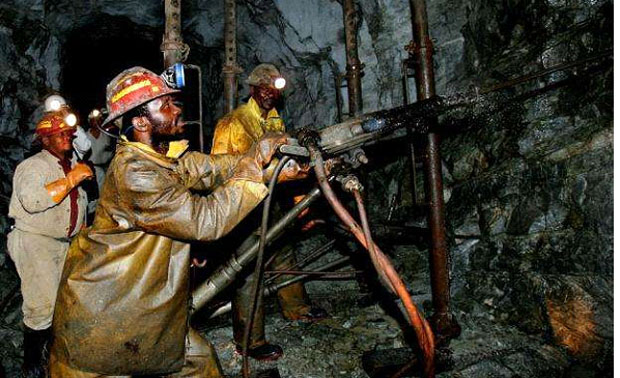Some underground miners busy at work
The mining sector’s corporate tax receipts increased by 39 per cent from GH¢696.9 million in 2016 to GH¢969.6 million in 2017 while mineral royalty revenue also increased by 28 per cent to GH¢ 702.4 million.
Employee income tax (pay-as-you-earn) increased from GH¢399.9 million in 2016 to GH¢ 487.9 million in 2017, a 22 per cent increase.
Kwame Addo Kufuor, outgoing president of the Ghana Chamber of Mines, who disclosed this, said this impressive upturn in fiscal revenue performance of the sector was primarily attributable to increased mineral production.
He said the growth in mineral revenue also reflected in the mining industry’s share of total merchandize export in 2017, which at 43% exceeded the contributions of both cocoa and oil.
“This supported Ghana’s balance of payments position and helped improve the country’s Gross International Reserve situation and its associated positive impact on the stability of the Ghana cedi.
“One issue that remains critical to stakeholders of the industry is job creation. Our records show that total direct employment by the producing member companies of the Chamber reduced from 11,628 in 2016 to 10,503 in 2017. Out of the 10,503 direct employees, 159 were expatriates, representing 1.5 per cent of the workforce.
“The reduction in the industry’s work force is attributable mainly to the limited labour rationalization measures undertaken by Golden Star Resources and Abosso Goldfields Limited to shift from owner to contract mining.”
Mr Addo Kufuor revealed that total mining fiscal receipts mobilized by the GRA increased by 31 per cent from GH¢1.65 billion in 2016 to GH¢2.16 billion in 2017.
“This also translates into 16.3 percent of domestic direct revenue mobilized by the GRA in 2017.”
Ghana maintained her position as the 10th largest producer of gold globally and second in Africa.
Total amount of money spent by gold producing member companies on goods and services procured from in-country suppliers and manufacturers was US$1.23 billion in 2017.
“This represents 34 per cent of realized mineral revenue and an increase in the preceding year’s spending. There is room for entrepreneurs in the local economy to increase their participation in the value chain,” he stated.
Eric Asubonteng is the new president of the Chamber.
By Samuel Boadi


